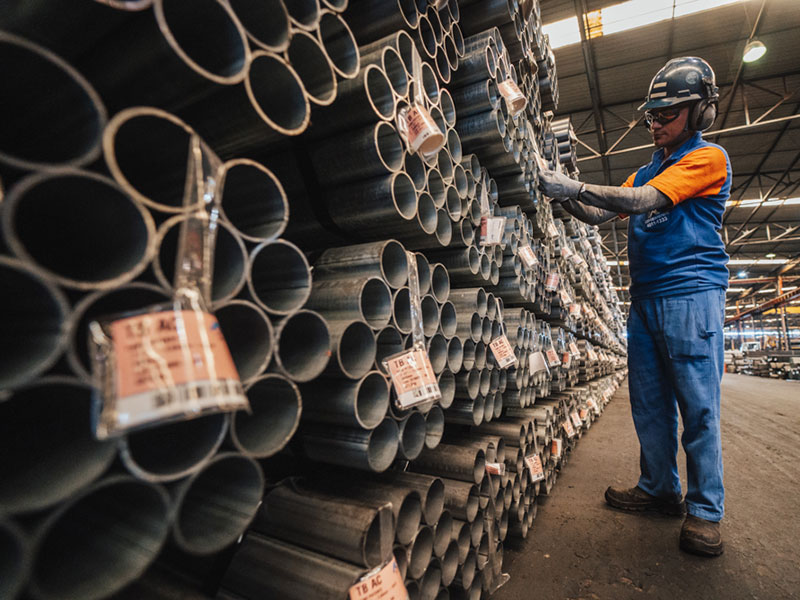
One of the greatest advantages of steel as a material is its versatility. Depending on how it is processed, it can acquire various specific qualities, such as greater ductility, strength, or weldability. One of the best examples of this is the galvanizing process.
Galvanized steel is already widely used in various fields, especially in construction. Therefore, there is high demand for suppliers of this material throughout the country. Therefore, it's worth learning more about how this material is processed and its main qualities.
Follow along and better understand what the galvanizing process is, how it works, and the benefits it brings to steel.
The different ones types of steel They acquire their properties based on the alloy's composition and how it is processed. Galvanizing is one such process, which involves coating the steel with a protective layer of zinc.
A steel coil is coated in zinc, including a film around it and creating a galvanized coilThe main purpose of galvanizing is to protect steel against rust, the main reason for maintaining the material.
This process can occur in two ways, which we will see below.
In this case, zinc is applied using methods that do not require heat, such as a spray aerosol or by electrolysis. The spray It is less used in the manufacture of galvanized steel, being more common in the correction of defects or in the maintenance of galvanization.
In the second case, the part is immersed in a chemical bath, which reacts with the steel. This provides a more complete galvanization of the part, in addition to allowing the production of steel in different colors, such as bluish, yellowish, or black hues. In other words, it can also be a relevant procedure for the aesthetic finish of the part.
Alternatively, it is possible to carry out the hot-dip galvanizing process, in which the steel part is bathed in molten zinc at approximately 455ºC and then left to cool.
In addition to ensuring coverage of the entire surface, this method has the benefit of increasing the strength of the piece as a whole, as the film becomes denser and more uniform. Ideal for application of steel in more rigid structures.
When performed correctly, the galvanizing process offers a range of benefits for steel, many of which are crucial for its application in construction. See some of the positive results of this process.
As mentioned, one of the main problems with many metals in construction is oxidation, which damages their structure. This is the case with standard steel, an alloy made primarily of iron and carbon. Considering that it can be used in outdoor areas to compose structures important, it needs to be as durable as possible.
This is the main purpose of steel galvanization. The outer zinc film acts as a protective layer against corrosion. This slows and reduces oxidation, reducing the risk of damaging the steel and, consequently, reducing long-term maintenance costs. This is particularly important for larger structures or outdoor areas, for example.
Another important factor when evaluating a steel part is its resistance to pressure and distortion. For example, when used as structural steel, it must be able to withstand greater pressure without distorting to ensure the durability and longevity of the project as a whole. Steel grades are selected based on these requirements.
The galvanizing process, as mentioned, also contributes significantly to this aspect, increasing the mechanical strength of the produced part. This is even more noticeable in hot-dip galvanizing, which produces an item with higher resilience. That's why this method is the most recommended for production. steel for certain structures.
Some processes used to work steel and obtain better properties can be quite complex, time-consuming, and expensive. This impacts production capacity, as well as the cost of the final product. It's difficult to obtain a large enough shipment of a specific steel if its production takes too long to deliver on time.
Fortunately, galvanizing doesn't usually present this problem. On the contrary, it's one of the simplest and most practical ways to obtain high-quality steel. resistance mechanical and corrosion protection, as it doesn't require complex techniques. It simply needs to be practiced and exercised regularly within your business to ensure the best use of available resources.
The visual and aesthetic quality of steel is also a strong attraction for many projects. Variations with a smoother, cleaner appearance are highly sought after in various architectural models, furniture construction, and more. Therefore, it's important to consider this aspect during production, in addition to proper polishing and finishing.
The galvanizing process is quite useful here, as the final product has a very elegant and refined appearance. And, depending on the process used, it can even have a more distinct color, ideal for creating certain facades or decorative pieces, for example.
After the galvanizing process, all that remains is to transform the steel into a part that can be used directly. Galvanized steel is primarily used in the production of metal tiles, pipes, sheets, cables, and steel profiles.
In addition, of course, there are some custom-made pieces for specific projects. Their durability and aesthetics are also complemented by their variety and versatility.
Now you better understand the galvanizing process and its main benefits. Considering that this is one of the most sought-after types of steel, it's important to consider its production and how it can be applied in different contexts.
Want to continue learning more about steel and its qualities? Then visit the website Ceará Steel Group and learn more about our work.